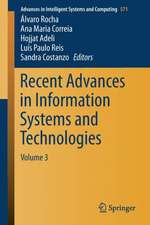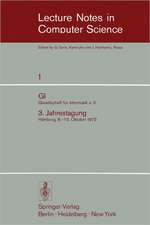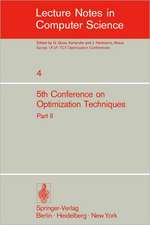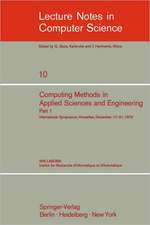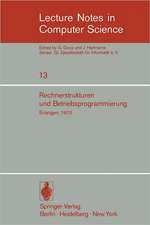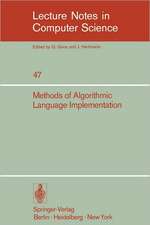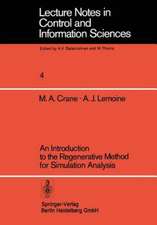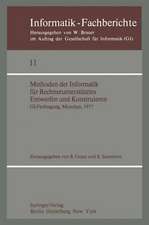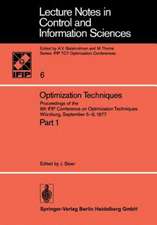Bioinspired Computation in Artificial Systems: International Work-Conference on the Interplay Between Natural and Artificial Computation, IWINAC 2015, Elche, Spain, June 1-5, 2015, Proceedings, Part II: Lecture Notes in Computer Science, cartea 9108
Editat de José Manuel Ferrández Vicente, José Ramón Álvarez-Sánchez, Félix de la Paz López, Fco. Javier Toledo-Moreo, Hojjat Adelien Limba Engleză Paperback – 9 iun 2015
The total of 103 contributions was carefully reviewed and selected from 190 submissions during two rounds of reviewing and improvement. The papers are organized in two volumes, one on artificial computation and biology and medicine, addressing topics such as computational neuroscience, neural coding and neuro-informatics, as well as computational foundations and approaches to the study of cognition. The second volume deals with bioinspired computation in artificial systems; topics alluded are bio-inspired circuits and mechanisms, bioinspired programming strategies, and bioinspired engineering AI&KE.
Din seria Lecture Notes in Computer Science
- 20%
 Preț: 1061.55 lei
Preț: 1061.55 lei - 20%
 Preț: 307.71 lei
Preț: 307.71 lei - 20%
 Preț: 438.69 lei
Preț: 438.69 lei - 20%
 Preț: 579.30 lei
Preț: 579.30 lei -
 Preț: 410.88 lei
Preț: 410.88 lei - 17%
 Preț: 427.22 lei
Preț: 427.22 lei - 20%
 Preț: 596.46 lei
Preț: 596.46 lei - 15%
 Preț: 448.04 lei
Preț: 448.04 lei - 20%
 Preț: 353.50 lei
Preț: 353.50 lei -
 Preț: 389.49 lei
Preț: 389.49 lei - 20%
 Preț: 309.90 lei
Preț: 309.90 lei - 20%
 Preț: 645.28 lei
Preț: 645.28 lei - 20%
 Preț: 763.23 lei
Preț: 763.23 lei - 15%
 Preț: 580.46 lei
Preț: 580.46 lei - 20%
 Preț: 310.28 lei
Preț: 310.28 lei - 20%
 Preț: 655.02 lei
Preț: 655.02 lei - 20%
 Preț: 1183.14 lei
Preț: 1183.14 lei - 20%
 Preț: 340.32 lei
Preț: 340.32 lei -
 Preț: 449.57 lei
Preț: 449.57 lei - 20%
 Preț: 591.51 lei
Preț: 591.51 lei - 18%
 Preț: 938.83 lei
Preț: 938.83 lei - 20%
 Preț: 337.00 lei
Preț: 337.00 lei - 20%
 Preț: 649.50 lei
Preț: 649.50 lei - 20%
 Preț: 607.40 lei
Preț: 607.40 lei - 20%
 Preț: 1414.79 lei
Preț: 1414.79 lei - 20%
 Preț: 1024.44 lei
Preț: 1024.44 lei - 20%
 Preț: 583.40 lei
Preț: 583.40 lei - 20%
 Preț: 453.32 lei
Preț: 453.32 lei - 20%
 Preț: 575.49 lei
Preț: 575.49 lei - 20%
 Preț: 1075.26 lei
Preț: 1075.26 lei - 20%
 Preț: 585.88 lei
Preț: 585.88 lei - 20%
 Preț: 825.93 lei
Preț: 825.93 lei - 17%
 Preț: 360.20 lei
Preț: 360.20 lei - 20%
 Preț: 763.23 lei
Preț: 763.23 lei - 20%
 Preț: 340.32 lei
Preț: 340.32 lei - 20%
 Preț: 504.58 lei
Preț: 504.58 lei - 20%
 Preț: 369.13 lei
Preț: 369.13 lei - 20%
 Preț: 580.93 lei
Preț: 580.93 lei - 20%
 Preț: 343.62 lei
Preț: 343.62 lei - 20%
 Preț: 350.21 lei
Preț: 350.21 lei - 20%
 Preț: 583.40 lei
Preț: 583.40 lei - 20%
 Preț: 583.40 lei
Preț: 583.40 lei - 15%
 Preț: 438.59 lei
Preț: 438.59 lei - 20%
 Preț: 341.95 lei
Preț: 341.95 lei - 20%
 Preț: 238.01 lei
Preț: 238.01 lei - 20%
 Preț: 538.30 lei
Preț: 538.30 lei
Preț: 341.81 lei
Preț vechi: 427.26 lei
-20% Nou
Puncte Express: 513
Preț estimativ în valută:
65.43€ • 71.09$ • 54.99£
65.43€ • 71.09$ • 54.99£
Carte tipărită la comandă
Livrare economică 21 aprilie-05 mai
Preluare comenzi: 021 569.72.76
Specificații
ISBN-13: 9783319188324
ISBN-10: 3319188321
Pagini: 480
Ilustrații: XXIV, 462 p. 177 illus.
Dimensiuni: 155 x 235 x 30 mm
Greutate: 0.68 kg
Ediția:2015
Editura: Springer International Publishing
Colecția Springer
Seriile Lecture Notes in Computer Science, Theoretical Computer Science and General Issues
Locul publicării:Cham, Switzerland
ISBN-10: 3319188321
Pagini: 480
Ilustrații: XXIV, 462 p. 177 illus.
Dimensiuni: 155 x 235 x 30 mm
Greutate: 0.68 kg
Ediția:2015
Editura: Springer International Publishing
Colecția Springer
Seriile Lecture Notes in Computer Science, Theoretical Computer Science and General Issues
Locul publicării:Cham, Switzerland
Public țintă
ResearchCuprins
Online Control of Enumeration Strategies via Bat-Inspired Optimization.- LEXMATH - A Tool for the Study of Available Lexicon in Mathematics.- Low-Power Occupancy Sensor for an Ambient Assisted Living System.- Evolution of Synaptic Delay Based Neural Controllers for Implementing Central Pattern Generators in Hexapod Robotic Structures.- Genetic Algorithm for the Job-Shop Scheduling with Skilled Operators.- Preliminary Design of the Real-Time Control Software for the Adaptive Optics of AOLI.- Graph-Based Learning on Sparse Data for Recommendation Systems in Social Networks.- Self-sampling Strategies for Multimemetic Algorithms in Unstable Computational Environments.- On the Influence of Illumination Quality in 2D Facial Recognition.- A Binary Cuckoo Search Algorithm for Solving the Set Covering Problem.- State Machine Based Architecture to Increase Flexibility of Dual-Arm Robot Programming.- A Cellular Automata Model for Mobile Worm Propagation.- Evolving Cellular Automata to Segment Hyperspectral Images Using Low Dimensional Images for Training.-. Multicriteria Inventory Routing by Cooperative Swarms and Evolutionary Algorithms.- Embodied Evolution for Collective Indoor Surveillance and Location.- On the Spectral Clustering for Dynamic Data.- A Multiple-Model Particle Filter Based Method for Slide Detection and Compensation in Road Vehicles.- Pedestrian Tracking-by-Detection Using Image Density Projections and Particle Filters.- Comparative Study of the Features Used by Algorithms Based on Viola and Jones Face Detection Algorithm.- Experiments of Skin Detection in Hyperspectral Images.- Scene Recognition for Robot Localization in Difficult Environments.- Pyramid Representations of the Set of Actions in Reinforcement Learning.- Related Tasks Selection to Multitask Learning Schemes.- Towards Robot Localization Using Bluetooth Low Energy Beacons RSSI Measures.- Development of a Web Platform for On-line Robotics Learning Workshops Using Real Robots.- A Growing FunctionalModules Learning Based Controller Designed to Balance of a Humanoid Robot on One Foot.- Optimized Representation of 3D Sequences Using Neural Networks.- Object Recognition in Noisy RGB-D Data.- Topology Preserving Self-Organizing Map of Features in Image Space for Trajectory Classification.- A Comparative Study of Downsampling Techniques for Non-rigid Point Set Registration Using Color.- Robust Control Tuning by PSO of Aerial Robots Hose Transportation.- Visual Bug Algorithm for Simultaneous Robot Homing and Obstacle Avoidance Using Visual Topological Maps in an Unmanned Ground Vehicle.- Neural Modeling of Hose Dynamics to Speedup Reinforcement Learning Experiments.- Autonomous Robot Navigation Based on Pattern Recognition Techniques and Artificial Neural Networks.- Collaborative Group Formation Using Genetic Algorithms.- The CALIMACO Multimodal System: Providing Enhanced Library Services Using Mobile Devices.-Agent Based Modelling to Build Serious Games: The Learn to Lead Game.- An Augmented Reality Application for Learning Anatomy.- Data Cleansing Meets Feature Selection: A Supervised Machine Learning Approach.- Multicriterion Segmentation of Demand Markets to Increase Forecasting Accuracy of Analogous Time Series: A First Investigation.- A Self-Organising Multi-Manifold Learning Algorithm.- Artificial Metaplasticity for Deep Learning: Application to WBCD Breast Cancer Database Classification.- Comparing ELM Against MLP for Electrical Power Prediction in Buildings.-.Fish Monitoring and Sizing Using Computer Vision.- Computer-Aided Development of Thermo-Mechanical Laser Surface Treatments for the Fatigue Life Extension of Bio-Mechanical Components.- From Smart Grids to Business Intelligence, a Challenge for Bioinspired Systems.- Neural Recognition of Real and Computer-Designed Architectural Images.
Textul de pe ultima copertă
The two volumes LNCS 9107 and 9108 constitute the proceedings of the International Work-Conference on the Interplay Between Natural and Artificial Computation, IWINAC 2015, held in Elche, Spain, in June 2015.
The total of 103 contributions was carefully reviewed and selected from 190 submissions during two rounds of reviewing and improvement. The papers are organized in two volumes, one on artificial computation and biology and medicine, addressing topics such as computational neuroscience, neural coding and neuro-informatics, as well as computational foundations and approaches to the study of cognition. The second volume deals with bioinspired computation in artificial systems; topics alluded are bio-inspired circuits and mechanisms, bioinspired programming strategies, and bioinspired engineering AI&KE.
The total of 103 contributions was carefully reviewed and selected from 190 submissions during two rounds of reviewing and improvement. The papers are organized in two volumes, one on artificial computation and biology and medicine, addressing topics such as computational neuroscience, neural coding and neuro-informatics, as well as computational foundations and approaches to the study of cognition. The second volume deals with bioinspired computation in artificial systems; topics alluded are bio-inspired circuits and mechanisms, bioinspired programming strategies, and bioinspired engineering AI&KE.
Caracteristici
Includes supplementary material: sn.pub/extras




